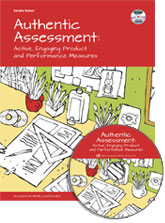Creative Assessment Strategies
Authentic Assessment: Active, Engaging Product and Performance Measures
by Sandra Schurr
(Association for Middle Level Education, 2012 – Learn more)
The day my copy of Authentic Assessment arrived, I scanned through the book and realized I had found the answers to recently arisen questions. Since hearing a keynote by Drive author Daniel Pink, I had been wondering how to integrate creativity into my middle school science classroom.
Opportunities for student creativity are infused throughout Sandra Schurr’s book, published last year by the Association for Middle Level Education. In fact, Authentic Assessment exemplifies the four essential attributes of effective middle schools defined in AMLE’s This We Believe document: they will be challenging, empowering, equitable, and developmentally responsible.
Clear, well-organized and actionable
 The book is clearly written with both teachers and students in mind. It reads quickly, is well organized, and provides lots of hands-on, ready-to-implement ideas.
The book is clearly written with both teachers and students in mind. It reads quickly, is well organized, and provides lots of hands-on, ready-to-implement ideas.
Schurr posits that authentic assessment “tests depth of knowledge…encourages critical and creative thinking…involves students very actively…and adapts…to unique strengths, needs, and choices of students.” She divides the book into four sections.
Part I: Starting Points relies on a question and answer format to explain several ideas, including performance, product assessment and portfolios. Even after reading the book, I have trouble discerning between product and performance. I know that Schurr recognizes a difference between these ideas, but in my mind they still blend together. I found the later portion of Part I more helpful; Schurr provides an extensive list of ideas for product and performance formats as well as suggestions for conducting research. Educators interested in, or engaged in, a democratic classroom could readily hand Authentic Assessment, or part of it, to students.
The meat of the book is found in Part II: Fifty Authentic Assessment Strategies. Twenty-five of these 50 suggestions are explained in great detail. These ideas, like many in the book, are clearly written with a student audience in mind. The assessment descriptions and instructions are like a road map; students could approach them with almost any topic and successfully complete them. (The remaining 25 strategies are covered in an abbreviated fashion, much to my disappointment.)
For the first 25 ideas Schurr gives an overall description, a numbered planning section, assessment questions and ideas for incorporating technology. A classroom teacher could easily copy these authentic assessment ideas (the copyright in the book grants permission for photocopying for classroom use) and hand them to students. With little additional instruction, students and teachers could get right to work.
Authentic Assessment comes with a CD-ROM which has PDFs of all the assessment ideas (the second 25 are still abbreviated, alas). For a recent 6th grade unit on animals, I gave students a choice of producing an almanac, no-sew quilt, wall chart, or audience participation report as selected from the book. I took Schurr’s instructions from the PDF and modified them slightly for this unit. The students’ final products were much better than previous projects they had worked on thanks to the focused instruction, variety of choice, and engagement provided by Schurr’s assessments.
Part III: Additional Resources focuses on rubrics and assessment. Teachers and students can easily pick and choose from the various ideas given and create their own rubric. I really loved the self- assessment questions throughout the book; you can easily adapt them for any type of activity.
The final section, Part IV: Teacher Study Materials, was for me the least helpful portion of the book. It includes two literature readings focusing on 21st century literacy, as well as formative and summative assessments. Educators who are looking for research to support the use of authentic assessment strategies, however, may find this section particularly helpful.
Putting the book to work
As I read Authentic Assessment, I found myself taking both mental and written notes on how I would implement the various assessments. A few of the 50 were “old hat” to me, like a brochure, but many were new ideas such as creating a country/culture (which several of my students recently worked on during a study of space), a ‘challenge box,’ and a ‘hands-on report.’
For example, I envisioned my middle school students creating a ‘challenge box’ as a series of station activities for younger students in our school (I teach at a PK – 8th grade independent school that encourages interaction between older and younger students). As my students learn about a given topic, they will have to translate, teach and develop activities for younger students on the same topic.
I also saw myself utilizing some of Schurr’s strategies to improve student engagement during instruction. For instance, I may have students keep a ‘sketch journal’; at the end of each lesson students will draw a picture or diagram to summarize, and visualize, what they’ve learned.
Authentic Assessment was a quick read, yet it is full of detail, and I have found myself revisiting it numerous times. Although I am an experienced teacher, the book definitely expanded my ‘bag of tricks.’ I have found that Schurr’s ideas have spurred my practice by providing more application of material, deeper thinking, greater engagement, and more student-driven work.
Tracey Muise, currently at St. George’s Episcopal School in Milner, GA, has been engaging and challenging middle school students for over 15 years in a science classroom. Previously she taught at the Episcopal School of Knoxville (TN), Girls Preparatory School (Chattanooga, TN) and the Edmund Burke School (Washington, DC). She earned her M.S. in environmental education in 1996 from Antioch New England Graduate School and her undergraduate degree in biology, in 1990, from Drew University.



































